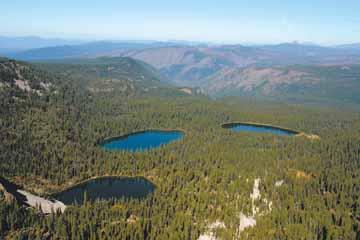|
Fall's the time to explore Sky Lakes Wilderness
 |
Zach Urness/Daily Courier
The Seven Lakes Basin, seen here from Devil's Peak, is one of the three lake basins in the Sky Lakes Wilderness, which is located east of Butte Falls. |
Autumn is the best time to go backpacking or hiking in the Sky Lakes Wilderness — one of the most popular wilderness areas in Southern Oregon — due mainly to the lack of mosquitoes and people. Here’s a photo gallery of the Sky Lakes, and here’s a video. o o o oBy Zach Urness of the Daily CourierFrom the top of Devil’s Peak, you can look across the Seven Lakes Basin and trace a path carved by ancient ice.The massive tongue of a grayish blue glacier ripped through these High Cascade Mountains around 7,000 years ago, carving inch-by-inch below active volcanoes spitting red-hot lava into the sky and earth. Within that fusion of ice and fire, between the peaks of Mazama and McLoughlin, a landscape of stunning blue lakes was formed that in 1984 was designated as the Sky Lakes Wilderness. It’s difficult to imagine the slow chaos that created this scene now, looking across the valley bathed in October sun. A hawk glides mindlessly upon the waves of a canyon breeze, and the three lakes are little more than azure footprints in the carpet of lodgepole pines below. I’m traveling through the Sky Lakes for the second time this autumn, which is without question the best time to explore Southern Oregon’s favorite patch of backcountry trails. Because despite its beauty, the Sky Lakes, Seven Lakes and Blue Canyon basins are home to a creature that can ruin even the best laid plans. o o o The first time I went backpacking into the Sky Lakes Wilderness, I was assaulted by a hoard of mosquitoes that would rival the biblical plagues of the Old Testament. It was two years ago in early July, and as I drove east of Butte Falls toward the trailhead, I couldn’t have been more excited about spending a few nights in the mountains. But there were warning signs almost immediately. When I pulled into the parking lot, I saw two backpackers with mosquito-net hats flopped over their heads, while I had only a small bottle of weak bug dope. This would be a powerful mistake. From the moment I came across the first small, pure lake, I became a gigantic piece of fresh meat on the spit. The tiny vampires swarmed around my head like comets orbiting the sun, buzzing into my ears and nose with the speed of kamikaze pilots. At one point I ate lunch with my head tucked inside my sweatshirt. In the evening I attempted to hide inside the smoke of my campfire. The only place I found peace was swimming underwater, and once I came back to shore, it was as though they were waiting for me along the muddy shoreline. The trip was more endured than enjoyed, and the memories were not of crystal clear lakes but of exotic schemes to escape the mosquitoes. All of that changed this past autumn during two trips back into the only backcountry destination I haven’t completely enjoyed during my time in Southern Oregon. And from the moment I entered Blue Canyon Basin early this October, I could tell something was different. The pastel colors of red and orange and gold leaves ornamented the edges of the trail, and the air smelled of warm pine sap as I hiked with a pack slung tightly over my shoulders. After just two miles I came across spectacular Blue Lake, which reflected a shimmering mirror of the silver cliffs jetting overhead on its surface. All of this was registered before I happened to notice that something was missing. But what? Ah yes, the mosquitoes. They were gone. Done. Slaughtered by the cold autumn nights. As quickly as they appear from the snow-melt of July, the bane of the Sky Lakes usually stop being a problem by September and are completely gone by October. The disappearance of mosquitoes is joined by the disappearance of people, who generally crowd along popular trails during the summer months but can be found only in small doses once the school year begins. And so I hiked along the lonely trail through autumn colors, setting up camp near Blue Lake and heading toward the aptly named Horseshoe Lake for some trout fishing. There are 25 to 30 major lakes in this wilderness, with nearly 200 smaller ones that often dry up during the summer. I waded out into the clear, light blue water and felt the sun across my shoulders as I tossed floating jigs into places I hoped brook trout were hiding. Although brookies are the fish most commonly considered, there have been rumors of rainbow trout grown fat on the prodigious bugs of the Sky Lakes. I hoped to land one for supper. With the bites limited and the afternoon cooling, I packed up my gear and headed back to Blue Lake. I grabbed some kindling and larger logs from the dead wood scattered around my campsite and coaxed up a small flame within a rock fire pit. As the sunset glowed in purple hues against the cliffs above the lake, and the sweet wood smoke of the campfire surrounded my campsite, I thought about dinner and about the next day’s plans. I did not think about mosquitoes. o o o The fourth-grade classes at Riverside Elementary contributed to this report.
| 




